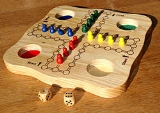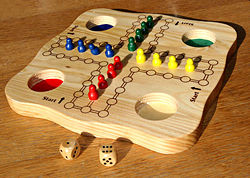
Mensch ärgere dich nicht
Encyclopedia
Mensch ärgere dich nicht is a German board game
(but not a German-style board game
), by Josef Friedrich Schmidt
(1907/1908).
The game was issued in 1914 and sold about 70 million copies. It is a Cross and circle game
with the circle collapsed onto the cross, similar to the Indian game Pachisi
, the colombian game Parqués
, the American games Parcheesi
and Trouble
, and the English game Ludo
.
.
 The game can be played by 2, 3 or 4 players – one player per board side (the original one has a pattern for 6 players on its backside). Each player has 4 game pieces, which are in the "out" area when the game starts, and which must be brought into the player's "home" row. Early games had painted wooden pieces.
The game can be played by 2, 3 or 4 players – one player per board side (the original one has a pattern for 6 players on its backside). Each player has 4 game pieces, which are in the "out" area when the game starts, and which must be brought into the player's "home" row. Early games had painted wooden pieces.
The rows are arranged in a cross position. They are surrounded and connected with a circle of fields, over which the game pieces move in clockwise direction. There are 3 fields nearest to each side of the board; the left one is the player's "start" field (marked "S") and the middle one leads to the "home" row.
This means that each game piece enters the circle at the "start" field, moves (clockwise) over the board and finally enters the "home" row. The first player with all of their pieces in their "home" row wins the game.
The players throw a die (dice) in turn and can advance any of their pieces in the game by the thrown number of dots on the dice.
Throwing a six means bringing a piece into the game (by placing one from the "out" area onto the "start" field) and throwing the dice again. If a piece is on the "start" field and there are still pieces in the "out" area, it must be moved as soon as possible. If a piece cannot be brought into the game then any other piece in the game must be moved by the thrown number, if that is possible.
Pieces can jump over other pieces, and throw out pieces from other players (into that player's "out" area) if they land on them. A player cannot throw out his own pieces though, and cannot advance further than the last field in the "home" row. A player cannot be thrown out if he is on his "start" field.
Variation which is played by most players: A player who has no pieces in the game has 3 tries to throw a six.
Board game
A board game is a game which involves counters or pieces being moved on a pre-marked surface or "board", according to a set of rules. Games may be based on pure strategy, chance or a mixture of the two, and usually have a goal which a player aims to achieve...
(but not a German-style board game
German-style board game
German-style board games, frequently referred to in gaming circles as Euro Games or Euro-style, are a broad class of tabletop games that generally have simple rules, short to medium playing times, indirect player interaction and abstract physical components...
), by Josef Friedrich Schmidt
Josef Friedrich Schmidt
Josef Friedrich Schmidt was a German board game inventor.- Biography :Schmidt was the inventor of board game Mensch ärgere dich nicht. He invented the game in 1907/1908....
(1907/1908).
The game was issued in 1914 and sold about 70 million copies. It is a Cross and circle game
Cross and Circle game
Cross and Circle is a board game design used for race games played throughout the world.-Design:Strictly, the design comprises a circle divided into four equal portions by a cross inscribed inside it; the classic example of this design is Yut...
with the circle collapsed onto the cross, similar to the Indian game Pachisi
Pachisi
Pachisi is a cross and circle board game that originated in ancient India which has been described as the "national game of India". It is played on a board shaped like a symmetrical cross...
, the colombian game Parqués
Parques
Parqués is the Colombian version of a board game in the cross and circle family . The game is described as a "random thinking" game: the moves depend on the roll of the dice but players must consider possible strategies before executing their move...
, the American games Parcheesi
Parcheesi
Parcheesi is a brand name American adaptation of the Indian Cross and Circle game Pachisi. Created in India perhaps as early as 500 AD, the board game is subtitled Royal Game of India because royalty played using color-costumed members of their harems as pieces on large outdoor boards. Such a court...
and Trouble
Trouble (board game)
Trouble is a board game in which players compete to be the first to send four pieces all the way around a board. Pieces are moved according to the roll of a die. Trouble was developed by the Kohner Brothers and initially manufactured by Irwin Toy Ltd., later by Milton Bradley...
, and the English game Ludo
Ludo (board game)
Ludo is a simple board game for two to four players, in which the players race their four tokens from start to finish according to dice rolls. Like other cross and circle games, it is similar to the Indian Pachisi, but simpler...
.
Name
The name of the game means "Do not get angry" (literally "Do not get angry, man" or "Do not get angry, buddy"). The name derives from the fact that a peg is sent back to the "out" field when another peg lands on it, similar to the game Sorry!Sorry! (game)
Sorry! is a board game that is based on the ancient Cross and Circle game Pachisi. Players try to travel around the board with their pieces faster than any other player. Distributed by Parker Brothers, Sorry! is marketed for two to four players, ages six through adult...
.
Rules

The rows are arranged in a cross position. They are surrounded and connected with a circle of fields, over which the game pieces move in clockwise direction. There are 3 fields nearest to each side of the board; the left one is the player's "start" field (marked "S") and the middle one leads to the "home" row.
This means that each game piece enters the circle at the "start" field, moves (clockwise) over the board and finally enters the "home" row. The first player with all of their pieces in their "home" row wins the game.
The players throw a die (dice) in turn and can advance any of their pieces in the game by the thrown number of dots on the dice.
Throwing a six means bringing a piece into the game (by placing one from the "out" area onto the "start" field) and throwing the dice again. If a piece is on the "start" field and there are still pieces in the "out" area, it must be moved as soon as possible. If a piece cannot be brought into the game then any other piece in the game must be moved by the thrown number, if that is possible.
Pieces can jump over other pieces, and throw out pieces from other players (into that player's "out" area) if they land on them. A player cannot throw out his own pieces though, and cannot advance further than the last field in the "home" row. A player cannot be thrown out if he is on his "start" field.
Variation which is played by most players: A player who has no pieces in the game has 3 tries to throw a six.

